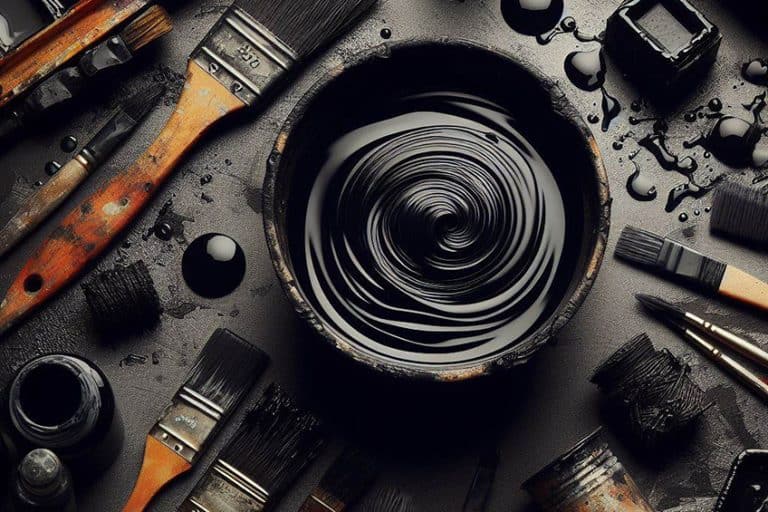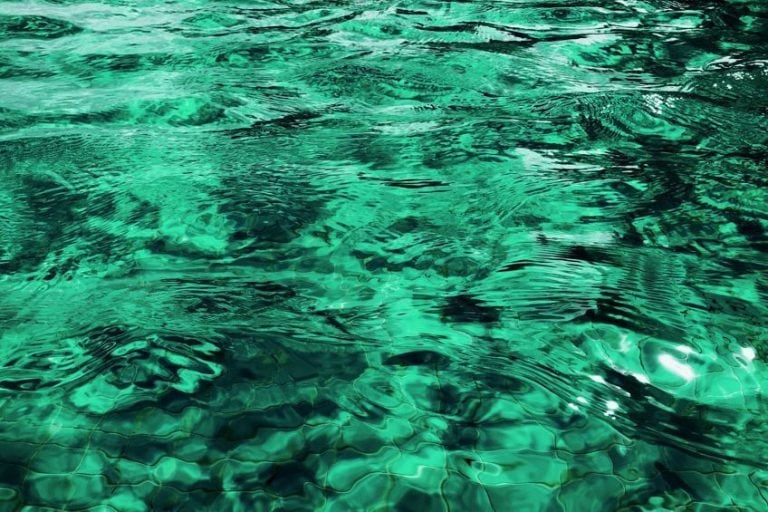What Color Does Blue and Brown Make? All You Need to Know
Blue is always going to be the color that reminds us of the ocean or clear skies. When we think of brown, it most probably makes us think of the earth and nature. These two colors have been used together for years to create all kinds of paintings. They also form a great pair in many other design possibilities, especially interior designs. However, what will happen if you mix blue and brown? Read further to discover the surprising answer to this question.
What Color Do Blue and Brown Make?
To provide a simple answer, mixing blue and brown makes a darker, muddier shade of blue. However, it is not that simple as there are many different shades of brown and blue that you can mix in different proportions. So, there is no real definitive answer. You can end up producing a variety of colors, ranging from a dark muted, or muddy blue, purple, and even a greenish teal, to a muddy brown, brown-gray, or even black.

However, whatever blue you use, the combination of blue and brown will always be a little darker and muted.
So, there is plenty of room for experimenting to see what happens when you mix blue and brown. Below is a simple example of mixing a standard blue with a dark brown, using an online color mixing tool. However, it does not reflect exactly what happens when paints are mixed. The color formed is a dark blue. The actual paint color will not look the same and will be more of a dark muddy blue.
| Shade | Hex Code | CMYK Color Code (%) | RGB Color Code | Color |
| Blue | #0000ff | 100, 100, 0, 0 | 0, 0, 255 | |
| Dark Brown | #46230a | 0, 50, 86, 73 | 70, 35, 10 | |
| Dark Blue | #231285 | 74, 86, 0, 48 | 35, 18, 133 |
Color Variations When Mixing Different Shades of Blue and Brown
| Blue Shade | Brown Shade | Mixed Color |
|---|---|---|
| #0000FF | #A52A2A | #521594 |
| #0000FF | #8B4513 | #452289 |
| #0000FF | #A0522D | #502996 |
| #0000FF | #D2691E | #69348e |
| #0000FF | #CD853F | #66429f |
| #0000CD | #A52A2A | #52157b |
| #0000CD | #8B4513 | #452270 |
| #0000CD | #A0522D | #50297d |
| #0000CD | #D2691E | #693475 |
| #0000CD | #CD853F | #664286 |
| #00008B | #A52A2A | #52155a |
| #00008B | #8B4513 | #45224f |
| #00008B | #A0522D | #50295c |
| #00008B | #D2691E | #693454 |
| #00008B | #CD853F | #664265 |
| #191970 | #A52A2A | #5f214d |
| #191970 | #8B4513 | #522f41 |
| #191970 | #A0522D | #5c354e |
| #191970 | #D2691E | #754147 |
| #191970 | #CD853F | #734f57 |
Understanding Blue and Brown As Colors
Brown and blue mixed may seem to be a bit challenging, because of all the variations available. However, let us try to understand red and green as colors first. Most of us have, at least, touched on color theory at school. The traditional color model, known as the RYB color model, is the most common system used for mixing paint colors. This system uses red, yellow, and blue as the primary colors. These particular hues cannot be created by blending any of the other colors.
So, blue is a primary color and can be found on the color wheel, along with all the other colors. Blue is also considered a cool color, along with green and purple. These colors are also all located on one side or half of the color wheel.
Brown, unfortunately, is technically not a hue or color, so it cannot be found on the color wheel. Brown is considered neutral, along with white, black, and gray. In color theory, when you mix two primary colors, you get your secondary colors like orange, green, and purple. If you mix a primary and secondary, you will get a tertiary or intermediate color, such as red-orange.

If you decide to mix all three of the primary colors, you will create a neutral brown or gray color. When looking at the color wheel, the complementary color sits directly opposite blue. So, directly opposite blue is orange, and when these two colors are placed next to each other, they appear to stand out. However, if you mix these two colors, you will create a shade of brown. Brown is often thought of as warm, but depending on the undertone, it can also be cool. For example, you can get a brown with cool blue undertones.
Meaning of Blue
The color blue is favored by many around the world and is often associated with freedom and open spaces. Blue is also perceived as a calming color that can help you relax and may even help lower your blood pressure. In psychology, blue is often the color used to help evoke feelings of trust and loyalty. Blue is also associated with honesty, reliability, and confidence. Blue is often associated with spirituality in some Eastern cultures.
Negatively, blue can be seen as depressing, predictable, and overly conservative.
Meaning of Brown
Since brown is associated with the earth, it is seen as a color that is grounding and dependable. Brown also offers security, and stability, and is perceived as a comforting color that also offers security and protection. However, brown can also be seen as dull and predictable.
Mixing Blue and Brown Paint
We have already been discussing the RYB color model and where blue and brown fit. We have found that there are slightly different outcomes, depending on the shade of color used and the proportions used. For example, if you take a dark blue and mix it with a standard brown, you will get an even darker and more muted blue. A subtractive color mixing system is used, where certain color wavelengths are absorbed, while others are reflected. If you mix a warmer brown, such as burnt umber with ultramarine blue, you will produce a shade close to black that has bluish undertones. You can also try mixing a little raw sienna, which is a yellowish-brown, with cobalt blue. This will produce a blue-gray or a more muted blue.

If you take a primary pure blue and mix this with a reddish brown, it will produce a darker brown that has a slight violet undertone. As you can see, you will need to experiment with the different shades and proportions to find out what happens with a combination of blue and brown.
You get a brown that comes in a tube, but you will need to understand the type of brown it is. This means you must know what pigments the manufacturer used. A brown can have more red or it can have more yellow. If you pick a brown that has more red and mix it with blue, it can produce a muted shade of purple. You can also choose a brown and blue that has more of a yellow undertone, to see if it will create something more greenish. For example, a burnt sienna mixed with a greenish blue, such as cyan will create a green khaki color.

All of this should be considered, as it will affect the outcome. You do have more control over the outcome if you mix your own brown color. You can choose the shade and amount of paint color you want to add. Experiment with mixing all three primary colors or try mixing a blue and orange, or a red and green to create a shade of brown. Just remember to keep a color palette as a reference, otherwise, you will not know how you produced a specific color.
Meaning of Dark Blue
When you mix blue and brown, it can produce many different results, depending on the shades of blue and brown, and the proportions used. However, if you mix a standard blue with brown, it produces a darker blue. Depending on the proportions, it can be a darker and muddier blue, or it can be a cool grayish brown. When considering the meaning of dark blue, it appears to be a mysterious color that is more mature than lighter blues.
Dark blues also represent authority, responsibility, and power.
Creating Lighter and Darker Shades
Once you have created your specific color, you can then adjust it by making it even darker or creating a lighter version. To create a lighter version is simple, all you need to do is keep adding small amounts of white paint. This creates a color tint. Brown and blue mixed usually create a darkish color to begin with. However, you can make it even darker by adding in more of the blue color you have on hand, or you can also try using black. If you do use black, only add very small amounts, as it can overwhelm the color easily.
Adding black is what creates a shade.
Understanding Blue and Brown in Other Color Models
Another color model that is often used today, is the RGB color system that is used to create colors on your laptop screen. So, it does not use pigments but lights or all colors in the visible spectrum of light to create color. This uses an additive color mixing system, where colors are overlaid to produce something that we perceive as color. In this model, red, green, and blue are your primary colors, while cyan, magenta, and yellow are your secondary colors.
As we have learned, you will get a brownish-to-grayish color when you mix all three primary colors in the traditional system. However, when you mix all three primary colors in this model, you will get white light.
There is no brown light in the visible light spectrum, so it does not naturally occur. However, you can get a color that resembles brown but is described as dark orange or red. Many colors, as we see them, do not really exist, and it is a matter of how our brain interprets things and how we perceive them. Below is an example of a “brown tone” that is actually a dark shade of orange.
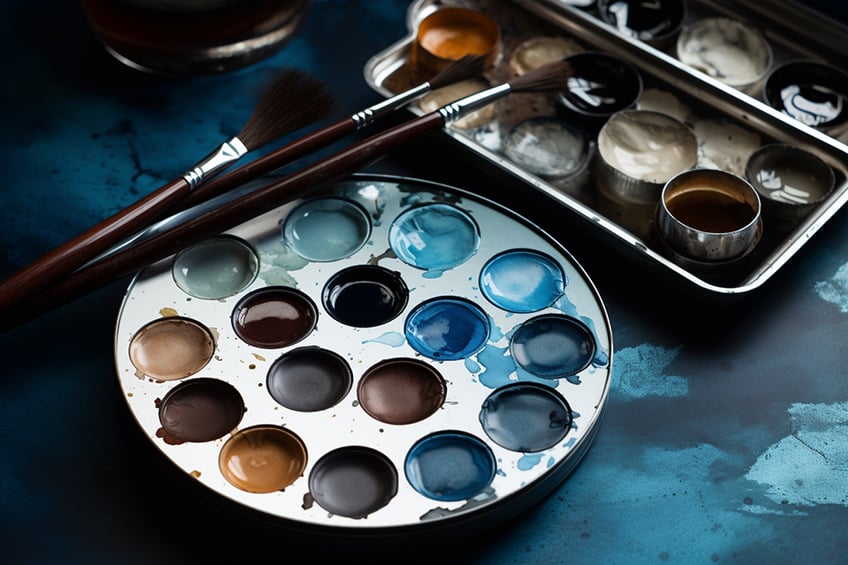
| Shade | Hex Code | CMYK Color Code (%) | RGB Color Code | Color |
| Brown | #964b00 | 0, 50, 100, 41 | 150, 75, 0 | |
| White | #ffffff | 0, 0, 0, 0 | 255, 255, 255 |
Printing Color Model
This color model is similar to the traditional model, in that it uses the subtractive mixing method. Also, it uses ink pigments to mix the different colors when you print something out. The primary colors for this include cyan, magenta, and yellow, while the secondary colors are reg, green, and blue. If you blend all of the primary colors, you will get black. If you check out the table above, you will see that there is a CMYK color code. This will show you how much there is of each color to create the brown. In this case, it is zero cyan, 50 percent magenta, 100 percent yellow, and 41 percent black.
Best Uses for Blue and Brown in Art and Design
Brown and blue, when used together, work wonderfully in any type of design. Brown is a neutral color and blue is calming, a perfect match. There are also many different shades of each color that you can work with to create the perfect match. You can also add other colors to bring in more interest. Other neutrals will go, such as white, gray, and black.
However, if you do go for more color, remember to choose your main color, and then bring in color more conservatively to bring in contrast, but not create a clash of colors. Darker blues can also be used to create a look that has more depth.

In art, blue is also a great color to work with when creating shadows. Blue is also used to depict more natural elements like the sky, water, and flowers. Brown is also used for painting natural elements such as mountains, but the different shades are also perfect for painting portraits.
Graphic Design
Color plays an important role in creating graphic designs for logos, and websites, and must be taken seriously if you want to create a brand that sends the right message. Blue is a calming, reliable, trustworthy, and confident color that is used by many well-known brands. Darker blues will add depth and a certain amount of sophistication.

Using brown and blue in a design offers a professional and reliable combination.
Fashion Design
All shades of blue are worn in the fashion world, as it is a popular color that is easy to work with. Navy blue is a fashionable dark blue that offers a more mature look and combines easily with other colors, especially neutrals like brown and white. Both blue and brown can work with most fashion styles from casual to formal wear.
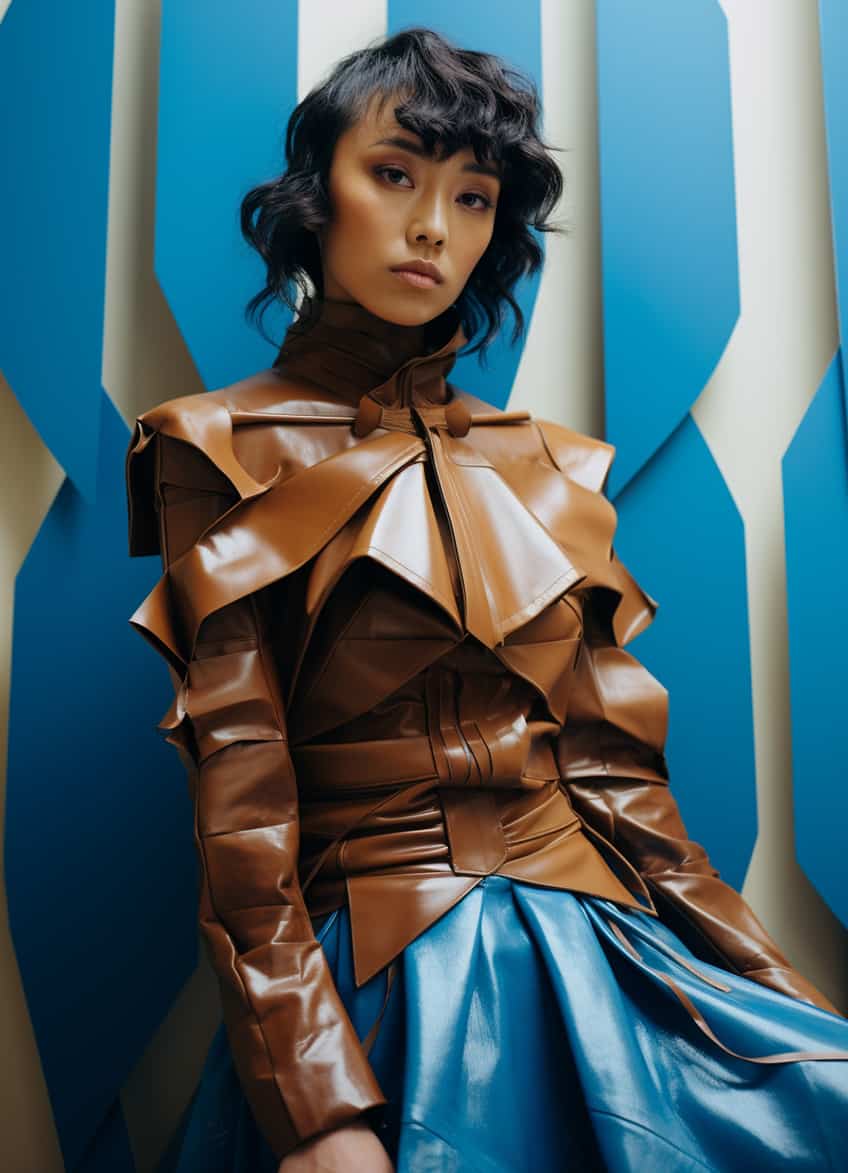
Interior Design
Dark blues can be used to create a calm and classic look, especially when paired with white. You can choose to add darker blues to the walls and bring on other neutrals, to create more of a cocooning effect. To make it lighter and more airy, consider using lighter blues, or bringing in the darker blues as accents. Brown also works wonderfully with blue, which can also be natural elements like wood or leather upholstery.
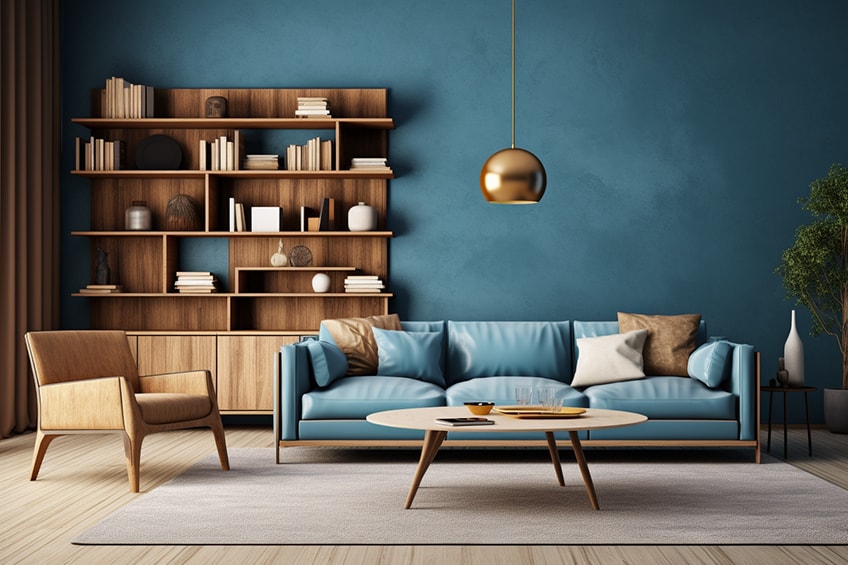
A combination of blue and brown is not as common as many other blends, however, it can be a way to experiment with mixing colors to see what happens. It is also a great way to learn how colors work together in different color models. Now that you have a basic understanding of what happens when mixing blue and brown, you can have fun while painting or creating various designs.
Frequently Asked Questions
What Color Does Blue and Brown Make?
In general, if you take a standard blue and you mix it with brown, it will create a darker and muddier shade of blue. Depending on the shades and ratios of blue and brown used, the results can vary. This means that in addition to the muddier blue, you can also produce varying shades of black, gray, brown, and even purple or green.
Is Brown a Shade of Orange?
Brown is considered a neutral color that is not found on the color wheel. However, it has been described as a darker shade of orange. As orange is a blend of red and yellow, you can get browns that lean towards either red or yellow.
Does Blue and Brown Make Purple?
There are many varieties of blue paint available. Some blue paints have more of a red undertone, while others have more of a blue undertone. If you use more of a reddish brown and mix it with a blue that has a red undertone, it should produce a shade of dark purple.
In 2005, Charlene completed her Wellness Diplomas in Therapeutic Aromatherapy and Reflexology from the International School of Reflexology and Meridian Therapy. She worked for a company offering corporate wellness programs for a couple of years, before opening up her own therapy practice. It was in 2015 that a friend, who was a digital marketer, asked her to join her company as a content creator, and this is where she found her excitement for writing.
Since joining the content writing world, she has gained a lot of experience over the years writing on a diverse selection of topics, from beauty, health, wellness, travel, and more. Due to various circumstances, she had to close her therapy practice and is now a full-time freelance writer. Being a creative person, she could not pass up the opportunity to contribute to the Art in Context team, where is was in her element, writing about a variety of art and craft topics. Contributing articles for over three years now, her knowledge in this area has grown, and she has gotten to explore her creativity and improve her research and writing skills.
Charlene Lewis has been working for artincontext.org since the relaunch in 2020. She is an experienced writer and mainly focuses on the topics of color theory, painting and drawing.
Learn more about Charlene Lewis and the Art in Context Team.
Cite this Article
Charlene, Lewis, “What Color Does Blue and Brown Make? All You Need to Know.” Art in Context. November 10, 2023. URL: https://artincontext.org/what-color-does-blue-and-brown-make/
Lewis, C. (2023, 10 November). What Color Does Blue and Brown Make? All You Need to Know. Art in Context. https://artincontext.org/what-color-does-blue-and-brown-make/
Lewis, Charlene. “What Color Does Blue and Brown Make? All You Need to Know.” Art in Context, November 10, 2023. https://artincontext.org/what-color-does-blue-and-brown-make/.







